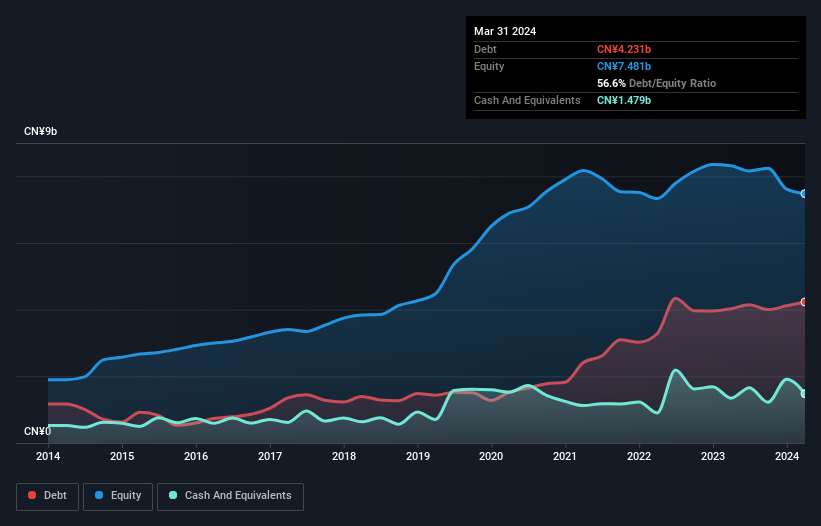
Warren Buffett famously said, 'Volatility is far from synonymous with risk.' When we think about how risky a company is, we always like to look at its use of debt, since debt overload can lead to ruin. Importantly, Wellhope Foods Co., Ltd. (SHSE:603609) does carry debt. But the more important question is: how much risk is that debt creating?
Why Does Debt Bring Risk?
Debt and other liabilities become risky for a business when it cannot easily fulfill those obligations, either with free cash flow or by raising capital at an attractive price. If things get really bad, the lenders can take control of the business. However, a more frequent (but still costly) occurrence is where a company must issue shares at bargain-basement prices, permanently diluting shareholders, just to shore up its balance sheet. Having said that, the most common situation is where a company manages its debt reasonably well - and to its own advantage. The first thing to do when considering how much debt a business uses is to look at its cash and debt together.
See our latest analysis for Wellhope Foods
What Is Wellhope Foods's Debt?
You can click the graphic below for the historical numbers, but it shows that as of March 2024 Wellhope Foods had CN¥4.23b of debt, an increase on CN¥4.03b, over one year. However, it does have CN¥1.48b in cash offsetting this, leading to net debt of about CN¥2.75b.

How Healthy Is Wellhope Foods' Balance Sheet?
The latest balance sheet data shows that Wellhope Foods had liabilities of CN¥3.83b due within a year, and liabilities of CN¥3.55b falling due after that. Offsetting this, it had CN¥1.48b in cash and CN¥1.56b in receivables that were due within 12 months. So it has liabilities totalling CN¥4.35b more than its cash and near-term receivables, combined.
This is a mountain of leverage relative to its market capitalization of CN¥6.47b. Should its lenders demand that it shore up the balance sheet, shareholders would likely face severe dilution. When analysing debt levels, the balance sheet is the obvious place to start. But ultimately the future profitability of the business will decide if Wellhope Foods can strengthen its balance sheet over time. So if you want to see what the professionals think, you might find this free report on analyst profit forecasts to be interesting.
In the last year Wellhope Foods wasn't profitable at an EBIT level, but managed to grow its revenue by 3.1%, to CN¥35b. We usually like to see faster growth from unprofitable companies, but each to their own.
Caveat Emptor
Importantly, Wellhope Foods had an earnings before interest and tax (EBIT) loss over the last year. To be specific the EBIT loss came in at CN¥258m. When we look at that and recall the liabilities on its balance sheet, relative to cash, it seems unwise to us for the company to have any debt. Quite frankly we think the balance sheet is far from match-fit, although it could be improved with time. For example, we would not want to see a repeat of last year's loss of CN¥579m. In the meantime, we consider the stock very risky. For riskier companies like Wellhope Foods I always like to keep an eye on the long term profit and revenue trends. Fortunately, you can click to see our interactive graph of its profit, revenue, and operating cashflow.
If, after all that, you're more interested in a fast growing company with a rock-solid balance sheet, then check out our list of net cash growth stocks without delay.
Valuation is complex, but we're here to simplify it.
Discover if Wellhope Foods might be undervalued or overvalued with our detailed analysis, featuring fair value estimates, potential risks, dividends, insider trades, and its financial condition.
Access Free AnalysisHave feedback on this article? Concerned about the content? Get in touch with us directly. Alternatively, email editorial-team (at) simplywallst.com.
This article by Simply Wall St is general in nature. We provide commentary based on historical data and analyst forecasts only using an unbiased methodology and our articles are not intended to be financial advice. It does not constitute a recommendation to buy or sell any stock, and does not take account of your objectives, or your financial situation. We aim to bring you long-term focused analysis driven by fundamental data. Note that our analysis may not factor in the latest price-sensitive company announcements or qualitative material. Simply Wall St has no position in any stocks mentioned.
About SHSE:603609
Wellhope Foods
Produces and sells feed products for pigs, poultry, ruminant animals, and other animals in China and internationally.
Undervalued with mediocre balance sheet.
Market Insights
Community Narratives




